Not everyone works with models. A lot of photographers have the job of shooting with everyday people and we need to make them look like models. So how do you do that when the subjects have no experience posing or controlling their face for the camera? Here are seven tips to make your portrait subjects feel like models.
- Pose the Hair
We don't generally think of hair as a part of the body we can control, but you really can! If you are shooting a subject with long hair, then bad hair is going to be the first thing anyone notices about your photo. There are no rules as to what looks "best" across the board. Everyone will look different with their hair a different way.
Let's assume you're doing a basic portrait session without makeup artists and hair stylists. The first thing to remember is that hair sitting on the shoulders looks terrible. If the hair sits on their shoulders, then it looks wild and you need to do something with it. There are five different things that they can do with their hair.
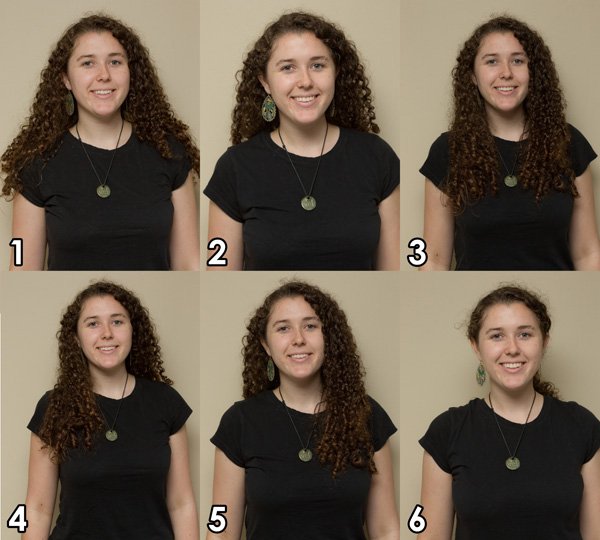
1 Hair all behind the shoulders.
2 Hair all in front of the shoulders
3 Hair all on one side.
4 Hair all on the other side.
5 Hair up.
Hair on the shoulders (#1) should be avoided at all costs. All of the other hair positions have their place depending on your model and the look you are trying to achieve. The reason I shot the hair on both sides (#4 and #5) is because the natural part in a person's hair will lend to one side looking better than the other.
Generally you want their part facing the camera so more of their face is included. For this tutorial, I chose hair up (#6) so we can more easily see the posing instructions without distraction. Many women see ponytails as the "day-off" hair style, but it actually lends itself very nicely in portraits and headshots since you have clean view of their face.
- Pull the Chin (or Ears) Forward
When someone stands in their normal relaxed stand, or even stands up straight to have nice posture, there is a little bit of flab right underneath their chin. No matter how skinny they are, you will see this. If you tell people to bring their chin forward, which sounds like the sensible thing to do, they will point their chin at you, which brings their face up and ends with you shooting up their nostrils. (Not attractive.) Instead, tell your model to bring their ears forward.
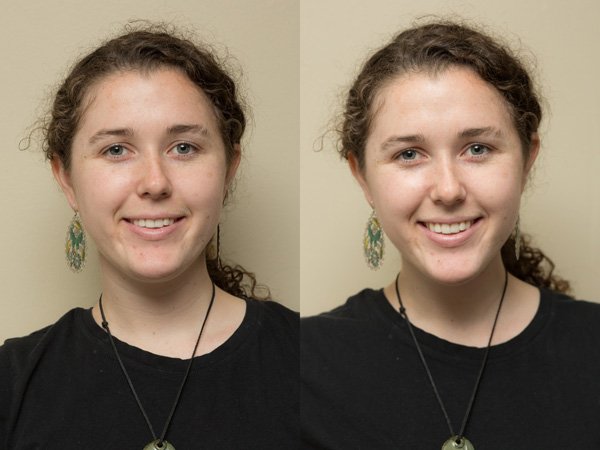
This demonstrates the before and after of telling them to bring their ears forward.
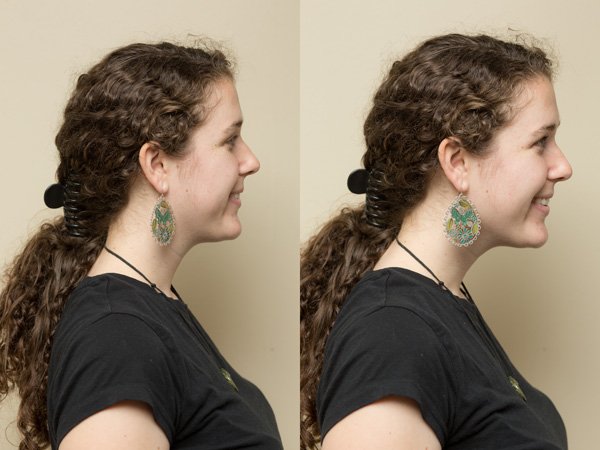
Same before and after from the side. Sometimes I call this "turtling," because they feel like a turtle coming out of their shell. It is a bit uncomfortable or unnatural, but the results are always worth it.
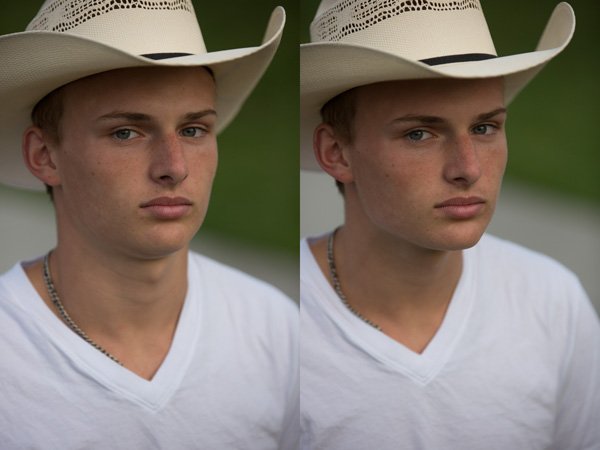
Same technique from a male subject. He was very fit and athletic, but our natural stance is not very photogenic.
- Lift the Arm
When people stand naturally, another thing they do is stand with their arms flat at their sides. This causes several problems. First, it makes them look awkward and uncomfortable in the photo. Secondly, their arm presses against their torso. This squishes the arm out and makes it look larger than it actually is.
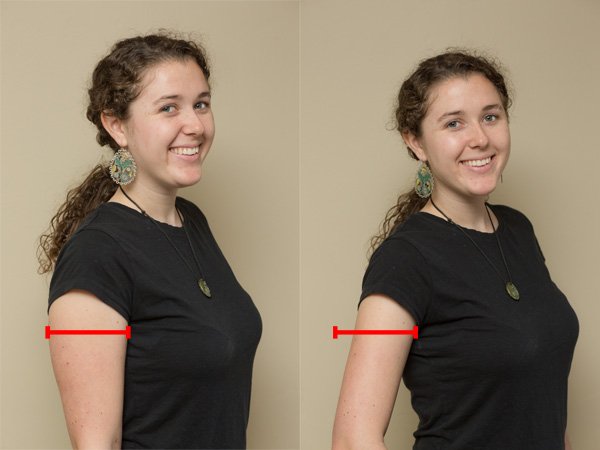
You can correct that by having them just lift their arm an inch or two so it is "floating" and not pressed against them. Alternatively, you can pose their hand so the arm is in a different position, such as putting their hand on the hip. In the image above, the red line is the size of the arm when standing unposed. The exact same red line was moved over to the second photo so you can see how much smaller the arm becomes when not pressed against the body.
- Leave Visual Space by the Waist
Everyone loves looking thin. One of the things you can do to trim down your subject is by giving them their "natural" waist, without any additives. What I mean by that is visually isolating the skinny part of the torso so they look as thin as they are. I had my model put her hands on her hips. The first photo shows no further posing. The arm in the back has no space between it and the torso, so it visually extends her mid-section. By having her pull the arm a little forward, you can see the space, so the waist doesn't have anything adding visual bulk.
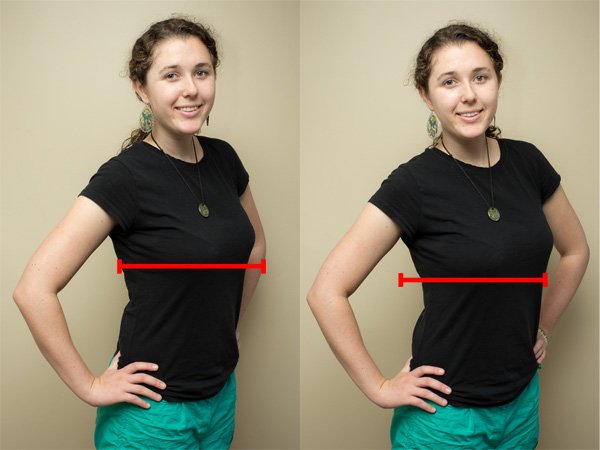
The red line shows the visual width of the subject from the first photo. It is replicated in the second photo to show how much width the arm actually adds. This rule does not just apply to arms. Anything that will be in the background of your subject and make them look larger can be an offender. A few examples are other people, tree trunks, or light poles.
- Turn the Shoulders
This is a very simple tip, but important. If your subject stares at the camera head-on, they look bigger. This can be good when shooting a football player or CEO of a big company, but it is bad when shooting beauty or portraits. By having your subject turn, they are showing a slimmer profile of themselves to the camera, and look slimmer.
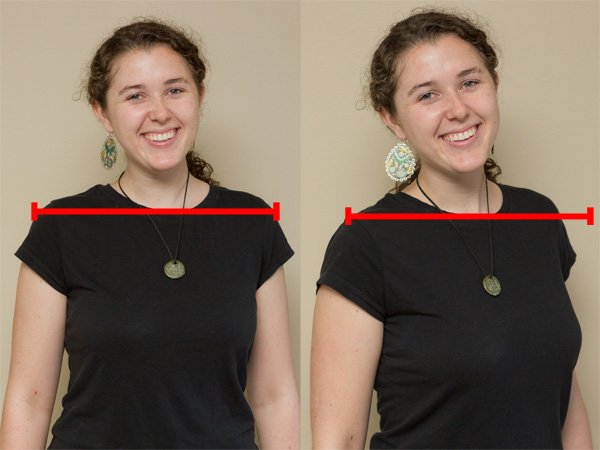
The red line shows the full width of the model when standing straight forward. A small turn to the side gives a photo that is still the subject facing the camera, but in a slimmer profile.
- Don't Show the Whites of the Eyes
When you want a far off, dreamy look and choose to have your subject look off camera, do not tell them to "look over there." Give them an object behind you to focus on so you can control their eyeline.
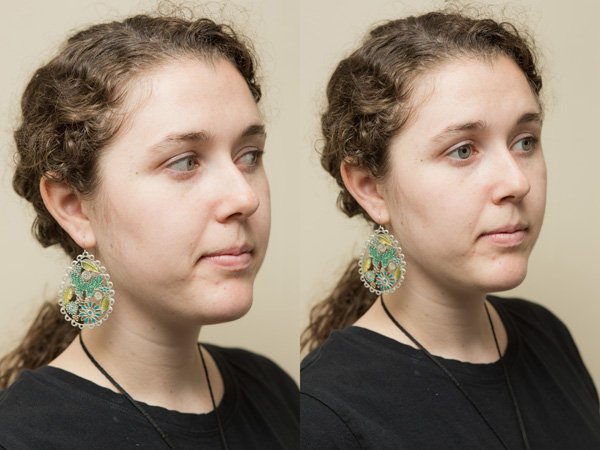
The first photo, I told the model to look out the door next to us. You can see the majority of the white of her eye, which is a bad thing. You want to see the iris, the colored part. I had her look out the window next to the door. That small change in eyeline brings back her eyes, gets rid of the white part, and gives a more attractive portrait.
- Don't Let the Nose Break the Face
This one is a bit more complex, but still important. When you don't want your subject facing forward, you have them turn to the side. Assuming you don't want a full profile where you only see one side of the face, they will be at a quarter turn with both eyes in frame. If you draw an imaginary line down the side of their face, this line is the line that cannot be crossed by their nose
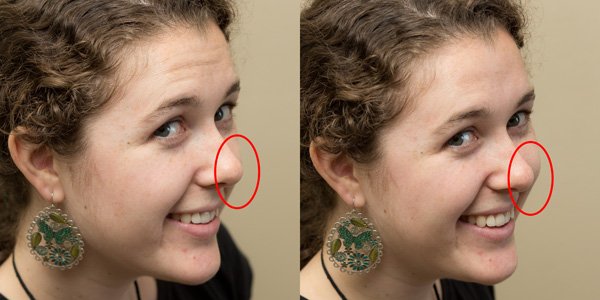
If they turn too far and the nose crosses this line, it "breaks" the natural curve of the face. It creates the "pinocchio" effect and extends the length of their nose. You can avoid this by having them turn back toward you slightly, until you can see a little bit of space between the end of their nose, and the side of their face. You don't want to break that line or it makes them look like they have disproportionate facial features.
Bringing it All Together
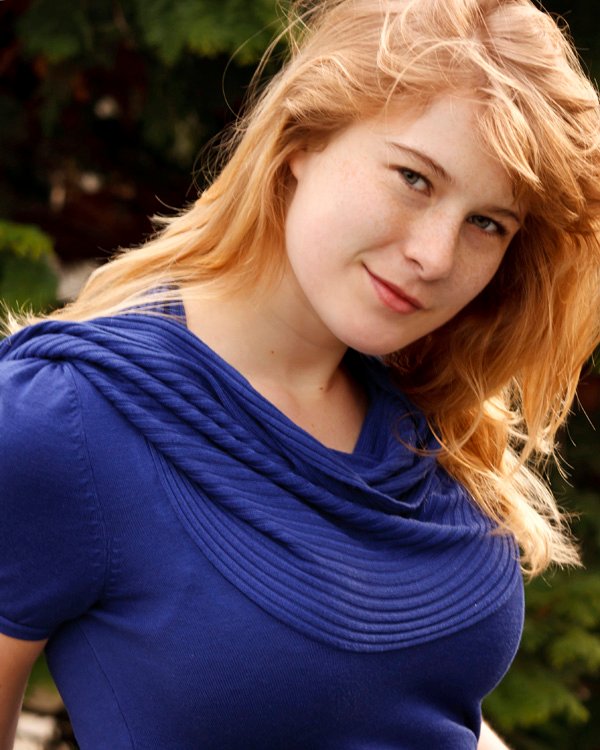
Here's a checklist you can follow for your next shoot.
Hair is behind one shoulder, in front of the other
Chin is forward to create a strong jawline
Arm is lifted from the torso
Waist doesn't have any visual extenders
Shoulders are turned
Iris is seen over the whites
Nose doesn't break the line of the face
What have you done to make everyday people feel like models? Let me know what you were able to do with these tips and share your own in the comments.
Hi! I am a robot. I just upvoted you! I found similar content that readers might be interested in:
https://photography.tutsplus.com/tutorials/7-posing-techniques-for-non-models--photo-15608
Downvoting a post can decrease pending rewards and make it less visible. Common reasons:
Submit
Thanks. I recently got into photography so any tips and hints are very useful. Might buy 50mm f1.8 for the portraits soon
Downvoting a post can decrease pending rewards and make it less visible. Common reasons:
Submit